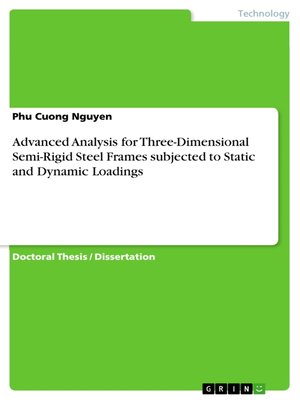Advanced Analysis for Three-Dimensional Semi-Rigid Steel Frames subjected to Static and Dynamic Loadings
ebook
By Phu Cuong Nguyen

Sign up to save your library
With an OverDrive account, you can save your favorite libraries for at-a-glance information about availability. Find out more about OverDrive accounts.
Find this title in Libby, the library reading app by OverDrive.



Search for a digital library with this title
Title found at these libraries:
| Library Name | Distance |
|---|---|
| Loading... |
Doctoral Thesis / Dissertation from the year 2014 in the subject Engineering - Civil Engineering, grade: 9.5, , course: Advanced Analysis of Steel Frames, language: English, abstract: The dissertation presents three various advanced analysis approaches which can capture accurately and efficiently the ultimate strength and behavior of steel framed structures with nonlinear beam-to-column connections subjected to static and dynamic loadings. Three major sources of nonlinearity are simultaneously considered in the analyses: (1) material nonlinearity; (2) geometric nonlinearity; and (3) connection nonlinearity. Three types of nonlinear beam-column element formulation considering both geometric and material nonlinearities are coded into two nonlinear structural analysis programs. Three types of steel frames analyzed by the developed programs are: (1) rigid frames; (2) linear semi-rigid frames; and (3) nonlinear semi-rigid frames. Three types of analysis can be performed: (1) nonlinear inelastic static analysis; (2) nonlinear elastic and inelastic time-history analysis; and (3) free vibration analysis. Three main resources of damping are taken into account in the developed programs are: (1) hysteretic damping due to inelastic material; (2) structural viscous damping employing Rayleigh damping; (3) hysteretic damping due to nonlinear beam-to-column connections. To solve nonlinear static equilibrium equations, the Generalized Displacement Control method is adopted herein because of their general numerical stability and efficiency. The GDC method can accurately trace the equilibrium path of nonlinear problems with multiple limit points and snap-back points. The modified Newton-Raphson method is utilized to apply fully static loads before the dynamic analysis procedure is executed. An incremental-iterative solution algorithm based on the Hilber-Hughes-Taylor method combined with the Newton-Raphson equilibrium iterative method is adopted for solving nonlinear equations of motion. Two computer programs are developed: (1) Nonlinear Structural Analysis Program (NSAP) – written in the C++ programming language; (2) Practical Advanced Analysis Program (PAAP) – written in the FORTRAN programming language. They are verified for accuracy and computational efficiency by comparing predicted results with those generated by the commercial finite element analysis packages of ABAQUS, SAP2000, and other studies. Through several numerical examples, the proposed program (PAAP) proves to be a reliable and efficient tool for practical engineering design.







